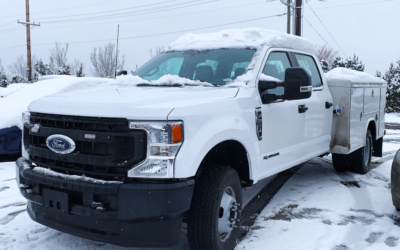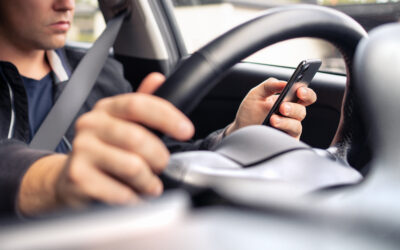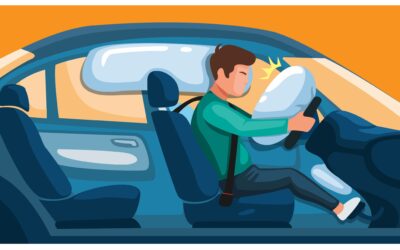Drowsy Fleet Drivers? Try Wearable Tech
Have you ever experienced difficulty in keeping your eyes open while driving? If you have, then you were drowsy driving!
Fatigue and sleep-deprivation in drivers is a real cause of concern. This is because drowsy drivers sitting behind the wheel can turn out to be a hazard for other people on the road. In fact, it’s one of the leading reasons for vehicular accidents. According to the National Safety Council, an estimated100,000 vehicle collisions and crashes every year are due to the driver being drowsy behind the wheel. These crashes result in over 1,550 people’s deaths and 71,000 injured people.
Effect of Drowsy Driving on Fleet Safety
When you take these stats and combine them with the grueling and demanding work hours of a fleet driver, then it definitely paints an alarming picture. Drowsy drivers are a liability to fleet safety and no individual should be allowed to drive unless they are in a state of complete cognizance. With that said, many fleet drivers experience fatigue and drowsiness daily while on the road due to the long hours that they have to drive. Furthermore, studies reveal that if you stay awake for more than 18 hours, then it is quite akin to being legally drunk!
This means that going without sleep for too long can impair your ability to drive the same way consuming too much alcohol does. Your body needs proper sleep regularly to function at an optimal level. If you don’t sleep for long hours, it will become increasingly difficult for you to concentrate, think straight, and drive safely. Lack of sleep affects your judgment, coordination, and reaction time and makes you less alert when driving – this translates into cognitive impairment, which causes road accidents.
Fatigue and drowsy fleet drivers can exhibit a wide range of dangerous behaviors such as drifting off the road, driving in the opposite lanes, erratic weaving, sudden braking, tailgating, excessive speeding, and more. This is why fatigue behind the wheels has the potential to be so deadly.
So, what can be done to ensure the safety of the drivers, vehicles, cargo, and other individuals and cars on the roads? This is where wearable technology to alert drowsy drivers comes into the picture!
Wearable Tech to Alert Drowsy Drivers
To ensure proper fleet safety and the safety of the drivers, many manufacturers are steadily launching more and more wearable technologies to alert drowsy drivers. According to a report by the Minneapolis Star Tribune, biometric sensors are becoming more advanced, lighter, accurate, and affordable. Moreover, new and improved software systems can now effectively connect vehicle date and drivers.
There is a ton of new wearable technology monitors that come in varied shapes, sizes, and forms such as vests, caps, glasses, and wristbands. This sensor technology works by recognizing signs that a driver is feeling drowsy and nodding off. These signs include sudden jerky movements and head bobs.
With that said, there are other sophisticated devices as well that are far more capable of detecting such behavior. For instance, SmartCap Technologies manufactures a headband that spots electronics brain waves and translates them to a measure of fatigue or alertness. It works wonderfully by notifying the drivers when they fall into the drowsy range, ensuring fleet safety.
Maven Machines manufactures a headset that monitors if a driver is looking up, sideways, down, or through the windshield. It also measures mirror checks, which can significantly lessen in frequency if a driver is feeling drowsy and getting tired. Another such wearable tech is the glasses manufactured by Optalert that use an LED light monitor to measure the driver’s eye blinking. Eyelids that stay down for an extended period might indicate drowsiness.
Even though such wearable technologies have definitely changed the landscape of fleet and driver security, the drivers and fleets also need to be proactive. They should take proper measures to ensure that the drivers are well-rested and never drowsy behind the wheel.
Signs of Driver Fatigue
Here are some signs of driver fatigue:
- Heavy and burning eyelids
- Frequent blinking and teary eyes
- Difficulty focusing
- Disconnected thoughts or daydreaming
- Erratic behavior while driving such as unnecessary and dangerous swerving
- Difficulty remembering exits or traffic signs
Tips to Prevent Driver Fatigue
Here are some helpful tips that the drivers can implement to prevent fatigue:
Get Appropriate Rest Before a Long Drive
Make sure to sleep for at least 7 hours before you start a long stretch of driving. If you are not feeling well or are tired, then don’t drive for long distances and plan your trip accordingly. Furthermore, even on your off days, stick to a good sleeping schedule.
Avoid Heavy Meals
If you want to avoid feeling drowsy behind the wheel, then don’t eat a heavy meal. Pack healthy and light on-the-road snacks such as nuts, fruits, trail mix, and hard-boiled eggs that can help you feel energized on your journey.
Take Proper Breaks
For every two hours that you drive, make sure to take at least a 15-minute break. Stop your vehicle, get out of it, stretch a little, and move your joints and legs. If you can and if it’s safe, then take a 15-minute nap to energize. Any longer than 15 minutes will leave you feeling sleepier than before.
The Bottom Line
Sleepy and fatigued drivers are detrimental to fleet safety. They exhibit driving patterns and behaviors that often lead to vehicular accidents. This is why fleets need to do everything in their power to ensure that their drivers are not drowsy or fatigued while behind the wheel. This is where wearable technology that can keep drivers alert comes in. It ensures that fleet drivers don’t endanger themselves and stay alert on their long job hours.






